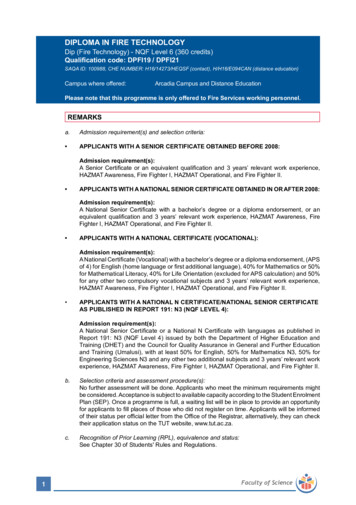
Transcription
Eindhoven University of TechnologyMASTERThe value of real options valuationa case studyMooren, P.J.H.Award date:2011Link to publicationDisclaimerThis document contains a student thesis (bachelor's or master's), as authored by a student at Eindhoven University of Technology. Studenttheses are made available in the TU/e repository upon obtaining the required degree. The grade received is not published on the documentas presented in the repository. The required complexity or quality of research of student theses may vary by program, and the requiredminimum study period may vary in duration.General rightsCopyright and moral rights for the publications made accessible in the public portal are retained by the authors and/or other copyright ownersand it is a condition of accessing publications that users recognise and abide by the legal requirements associated with these rights. Users may download and print one copy of any publication from the public portal for the purpose of private study or research. You may not further distribute the material or use it for any profit-making activity or commercial gain
Arnhem, September 2011The Value of Real OptionsValuation:A Case StudyBy P.J.H. Mooren (Pieter)BSc Industrial Engineering - 2009Student identity number: 0569468In partial fulfillment of the requirements for the degree ofMaster of Sciencein Innovation ManagementSupervisors:Prof. Dr. R.J. MahieuDr. M.J. ReindorpIr. T.J. PaffenEindhoven University of Technology, ITEMEindhoven University of Technology, OPACPPM Oost, Investment ManagerI
TUE. School of Industrial Engineering.Series Master Theses Innovation ManagementSubject headings: Entrepreneurial Finance, Financial Modeling, InvestmentAnalysis, Real Options, Valuation, Venture CapitalII
AbstractThis study focuses on the potential added value of a real options valuation approachover a DCF valuation approach for individual high potential start-ups. Throughoutliterature it is theorized that for valuations of high potential start-ups the real optionsmethodology would outperform the DCF method. However, due to a lack of focusedresearch, empirical evidence for the superior performance of the real optionsmethodology when individual ventures are valued is lacking. In this study, a real optionsvaluation tool is modeled and used to value selected cases within the portfolio of aventure capital firm; the results obtained are hereafter compared with the DCF basedvaluations and actual stock transactions present for the selected cases. Through thiscomparison, it is found that the real options method is better able to determine the valueof high potential start-ups than the DCF method. This study therefore concludes that amore accurate assessment of the value of high potential start-ups can be obtained bymaking use of the real options valuation method, these results are in line with claimsmade in literature and can be seen as the first empirical evidence for these claims on acase level. In this thesis also the performance of various real options methodologies isassessed, it is found that the relatively simple decision tree method performs equallywell compared to the quantitatively more complex binomial lattice method.III
Management SummaryIntroductionThis master thesis project is executed at Participatiemaatschappij Oost Nederland NV(PPM Oost), a publicly funded venture capital firm. The primary task of PPM Oost is toinvest public funds in start-up companies which through their activities make a positivecontribution to the economy and employment of East Netherlands. Due to this task, theventures in the portfolio of PPM Oost generally possess a large degree of strategicflexibility. In order to correctly determine the value of these ventures, the correctassessment of strategic flexibility is therefore of the utmost importance.Research QuestionIt is often theorized that the real options method should have a superior performanceover the Discounted Cash Flow (DCF) method due to the fact that the real optionsmethod specifically takes strategic flexibility into account. This is done through theassessment of an investment opportunity over time, as well as by considering strategicopportunities which exist after a project is engaged, such as discontinuing aninvestment. Although evidence is present on the superior performance of the realoptions method when a group of ventures is valued simultaneously, no empiricalevidence is present on the superior performance of the real options method whenindividual ventures are valued; therefore the following research question is stated:Can a valuation process based upon the DCF valuation method be improved by usingreal options theory to better determine the value of individual high potential start-ups?Design of a Real Options Valuation ModelIn order to answer this research question, an analytical framework was defined whichcould be used as a basis to design the real options valuation model. The analyticalframework defines two real option valuation methodologies to be used in the real optionsvaluation model; the “Decision Tree method” and the “Binomial Lattice method”. Theanalytical framework also defines a set of five characteristics through which a highpotential start-up should be defined in the real options valuation model; thesecharacteristics are the “Research Trajectory”, “Success Probabilities”, “Length ofPhases”, “Costs and Income of Phases” and the “Commercialization Trajectory” of aventure.Based on this framework, a real options valuation model was designed and tested whichcould be used to conduct valuation case studies within PPM Oost.Execution of the Case StudiesBased on seven selection criteria (Industry Fit, Presence of a DCF valuation, Presenceof another valuation, Presence of recent market transactions, Presence of comparables,Type of financing, and Reasons for rejecting), four ventures present in the red and whitebiotech industry were selected to be valued in the case study.IV
In Management Summary 1, the valuation results of the executed case studies areshown for each of the four cases1. The lowest valuation obtained through the realoptions model is set at 100%; all other valuations are adjusted accordingly. All realoptions and DCF valuations can be regarded to be current valuations. Moreover all stocktransactions, except for the semi- recent stock transaction of RedBIO1 are fairly recenttransactions, and can therefore be expected to be an accurate representation of thecurrent value of the ventures; therefore these stock transactions will be used as a proxyfor the market value of each venture. The market value of RedBIO1 is expected to besignificantly higher than the semi-recent stock transaction, as this stock transactionoccurred 1 year and three months ago.Management Summary 1: Overview Valuation Results (RedBIO1, RedBIO2, RedBIO3 and WhiteBIO1)AnalysisThrough the analysis of Management Summary 1 several observations can be made.Since the actual market value for RedBIO1 is expected to be considerably higher thanthe semi recent stock transaction, it can be expected that both the DCF method and thereal options method provide wrong results.oBoth the DCF method and the real options method provide a valuation which isfar from the actual market value of RedBIO1, the real options valuation is toohigh, the DCF valuation is too low.1Due to confidentiality companies are made anonymous, and valuations are given inpercentages.V
Moreover, it can be seen that the real options valuation method provides valuationresults very close to the market value for RedBIO2 and RedBIO3 whereas the DCFmethod produces valuation results which are very far from the market value.oThe real options method provides valuations which are very close to the actualmarket values of RedBIO2 and RedBIO3, whereas the DCF method provides avaluation which is either far too high or unrealistically low (negative).For WhiteBIO1, the DCF valuation and the real options valuation are similar. Althoughno actual market value is present it can therefore be stated that none of the twovaluations will provide a more accurate result than the other.oBoth the DCF method and the real options method provide a similar valuation.Results & Practical RelevanceBased on the analysis of the four case studies conducted, it can be stated that for allcases conducted, the real options valuation method provides a valuation result which isas close as, or closer to the actual market value than the valuation obtained through theDCF valuation method. Therefore the research question stated in the beginning of thismanagement summary can be answered by: Yes, a valuation process based upon theDCF valuation method can be improved by using real options theory to better determinethe value of individual high potential start-ups.Besides answering the main research question, multiple related questions wereanswered. The other major findings in this report are: The Decision Tree method and Binomial Lattice method provide identical results inmost cases. Since the Decision Tree method is more transparent in usage andeasier to implement, this method is most appropriate. The high potential start-up characteristics defined in the analytical framework areable to capture the most relevant characteristics to consider when adapting avaluation process. It is unclear whether industry specific characteristics have to beconsidered when start-ups outside of the biotech industry are valued.The practical relevance of this study is: Investment managers are better able to appropriately determine the value of highpotential start-ups in which already is, or might be invested. This promotes a betterallocation of scarce funds. Implementing a real options approach heightens the awareness of practitioners foroptions present in an investment; this awareness is one of the most importantcontributions of the real options model since valuable options are not discardedwithout consideration. The real options model requires less input than the DCF method, but an investmentmanager is still required to determine key sales and development numbers, requiringhim to consider the assumptions underlying the most important numbers. The real option valuation model requires practitioners to quantify risk and providesan insight into the actual effect of risk on the value of the venture.VI
“Price is what you pay. Value is what you get.”Warren Buffet, American Investor & EntrepreneurVII
PrefaceThis report is the result of my Master thesis project which I have conducted at PPMOost. This project represents the last part of my Master Innovation Management at theEindhoven University of Technology. Moreover, completing this Master is the final stepin my education towards becoming an Industrial Engineer.In the process of becoming an Industrial Engineer I was supported by a large number ofpeople, here I would like to take the opportunity to specifically mention some of thesepeople.During my internship at PPM Oost, I had the pleasure of having Tom Paffen as mycompany supervisor. His insights into the venture capital industry, his entrepreneurialspirit, and his ability to not take things too serious made my internship a very pleasantand insightful experience. Who also made my internship worthwhile were all my othercolleagues at PPM Oost who kept a continuous interest in my research, made time toanswer my questions and above all were pleasant colleagues to work with, thank you all.I would also like to thank my University supervisor, Mr. Mahieu, who always made timeto review my work, discuss difficulties I had, and provide me with thorough feedback. Hiscontinuous support and enthusiasm were a great support during the project and helpedme lift my work to a higher level. Also I would like to thank Mr. Reindorp, my secondUniversity supervisor, who showed a sincere interest in the project from the start onforward and contributed to the quality of this report greatly.Last but certainly not least, I would like to thank my parents, sister and the rest of myfamily for their love and support throughout the years, without them I certainly would notbe where I am today. Also I would like to thank all my friends, for making my time as astudent in Eindhoven such a fun and enjoyable time. I could not have finished mystudies without the (well timed) distractions from your part!Pieter MoorenArnhem, September 2011VIII
Table of ContentsAbstract. IIIManagement Summary . IVPreface . VIIITable of Contents. IX1. Introduction. 11.1 Introduction to the Problem . 11.2 Main Goal of the Master Thesis . 21.3 Content of this Report . 22. Research Question . 32.1 Theoretical Advantages of Real Options . 32.2 Empirical Advantages of Real Options . 32.3 Research Questions . 43. Research Steps . 64. Research Scope . 84.1 Company Setting .
(PPM Oost), a publicly funded venture capital firm. The primary task of PPM Oost is to invest public funds in start-up companies which through their activities make a positive contribution to the economy and employment of East Netherlands. Due to this task, the ventures in the portfolio of PPM Oost generally possess a large degree of strategicAuthor: Pjh Pieter MoorenPublish Year: 2011











